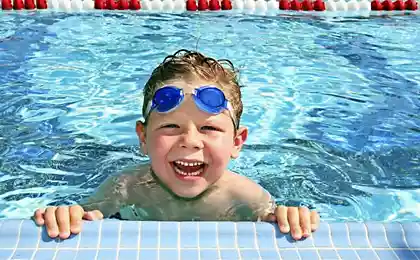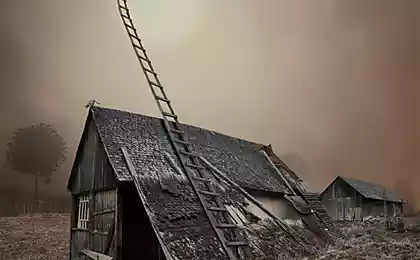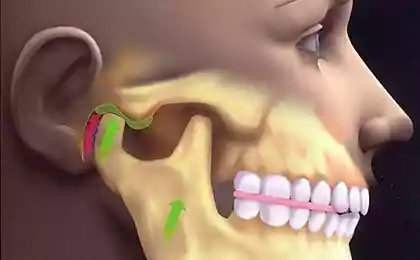436
A whiplash injury as a cause of scoliosis and posture disorders
Consider the mechanism of adaptation of the organism to injury during whiplash injury, or whiplash. First, there is trauma. This can be a direct blow, vehicle accident, or past hard labor.

It is necessary that this caused plastic deformation of the tissues. In the terminology of the school of Craniosacral therapy Upledger the traumatic effects should cause the displacement of the Central axis. The characteristic symptom of whiplash injury or whiplash is the offset of the Central axis of the body, and damage to the structure of the body may not be.
Next, the mechanism of adaptation of organismen for example, the side of injury the head.

Fig. As an example, the side of injury the head. Not compensated posture. After a period of recovery from whiplash injury (if he was) in the posture remains linear offset, or shift tissue obtained at the time of impact. In our case it is the horizontal offset of the head from side to (side shift). Have a upright standing person with the head and the pelvis will not be on the same vertical axis.
In posturologie it will not be compensated type of posture. Such a posture is stopped by the flight path, or fall of the body from the moment of impact. To maintain this vertical position, the body takes a lot of effort. Overexertion of the body, resulting in spasm of the tissue and defines the main symptoms in whiplash injury. After recovery from a possible scmt SGM, bruises, fractures, or other problems, obtained at the time of injury, for many years may remain persistent symptoms of whiplash.
The main symptoms of whiplash injury:
The stage adaptation of through a lateral tilt, or lateroflexion. To live vertically in a constant fall is extremely convenient for the body, and he tries to balance himself. A more comfortable posture to the body posture with the centers of gravity of all the major body parts on the same vertical axis. Then to maintain a posture to spend significantly less energy.
This can be achieved by creating a new arc of the spine, which will compensate for posture.

Fig. The stage adaptation of through a lateral tilt, or lateroflexion. Thus, the body is re-organized around the vertical axis. And offset "knocked out of the axis" part of the body is again embedded in the body and closer to the Central axis.
This adjustment period usually takes up to one year.
As a result, formed S-shaped scoliosis.

Fig. The stage adaptation of through a lateral tilt, or lateroflexion. During the inspection at this stage, when there is no rotation, is determined by a significant difference of height of standing of the shoulder girdle and the pelvic bones. But the twisting of the pelvis, the chest yet.
The stage adaptation by means of rotation. Our body continues to balance itself and new arcs are supplemented by rotation. This process occurs according to the biomechanics of the vertebrae according to the first rule Freeta.
The first law Fraietta: lateroflexion of the spine from the neutral position lateral tilt and rotation of the vertebrae occur in opposite directions. Thus formed the classical group the NSR dysfunction with lateral tilt in the opposite direction from the injury side and rotation to the side of the injury.
The appearance rotatiei the difference of height of standing of the shoulder girdle and pelvic bone becomes smaller in comparison with the previous stage, but voznikaet twisting of the pelvis, of the thorax.
See also: 8 foods that cause diseases of the respiratory tract
This drink improves the functioning of liver and kidneys
Treatment strategically can take place in the form of finding and correcting the area of primary injury. Another option: consistent trim of the diaphragm and cranio-sacral balancing.
P. S. And remember, only by changing their consumption — together we change the world! ©
Join us in Facebook , Vkontakte, Odnoklassniki
Source: osteopatbabkin.blogspot.ru/2013/11/viplash-skolioz.html

It is necessary that this caused plastic deformation of the tissues. In the terminology of the school of Craniosacral therapy Upledger the traumatic effects should cause the displacement of the Central axis. The characteristic symptom of whiplash injury or whiplash is the offset of the Central axis of the body, and damage to the structure of the body may not be.
Next, the mechanism of adaptation of organismen for example, the side of injury the head.

Fig. As an example, the side of injury the head. Not compensated posture. After a period of recovery from whiplash injury (if he was) in the posture remains linear offset, or shift tissue obtained at the time of impact. In our case it is the horizontal offset of the head from side to (side shift). Have a upright standing person with the head and the pelvis will not be on the same vertical axis.
In posturologie it will not be compensated type of posture. Such a posture is stopped by the flight path, or fall of the body from the moment of impact. To maintain this vertical position, the body takes a lot of effort. Overexertion of the body, resulting in spasm of the tissue and defines the main symptoms in whiplash injury. After recovery from a possible scmt SGM, bruises, fractures, or other problems, obtained at the time of injury, for many years may remain persistent symptoms of whiplash.
The main symptoms of whiplash injury:
- Wandering pain syndrome without any permanent radicular mission: month pain in the leg, then a month in hand, then a month in the other leg, etc.
- Significant stiffness in the movements of flexion, extension, side bending torso and neck. The immediate cause is the tension of the Dura mater, which as well as the pose tends to "not letting the body fall." Usually this symptom when visiting the neurologist referred to the widespread osteochondrosis, or may even be necessary to exclude ankylosing spondylitis.
- The disruption of the gastrointestinal tract according to the type of dyskinesia.
- Not the typical human emotional lability.
- Usually there is also fatigue, or General weakness.
The stage adaptation of through a lateral tilt, or lateroflexion. To live vertically in a constant fall is extremely convenient for the body, and he tries to balance himself. A more comfortable posture to the body posture with the centers of gravity of all the major body parts on the same vertical axis. Then to maintain a posture to spend significantly less energy.
This can be achieved by creating a new arc of the spine, which will compensate for posture.

Fig. The stage adaptation of through a lateral tilt, or lateroflexion. Thus, the body is re-organized around the vertical axis. And offset "knocked out of the axis" part of the body is again embedded in the body and closer to the Central axis.
This adjustment period usually takes up to one year.
As a result, formed S-shaped scoliosis.

Fig. The stage adaptation of through a lateral tilt, or lateroflexion. During the inspection at this stage, when there is no rotation, is determined by a significant difference of height of standing of the shoulder girdle and the pelvic bones. But the twisting of the pelvis, the chest yet.
The stage adaptation by means of rotation. Our body continues to balance itself and new arcs are supplemented by rotation. This process occurs according to the biomechanics of the vertebrae according to the first rule Freeta.
The first law Fraietta: lateroflexion of the spine from the neutral position lateral tilt and rotation of the vertebrae occur in opposite directions. Thus formed the classical group the NSR dysfunction with lateral tilt in the opposite direction from the injury side and rotation to the side of the injury.
The appearance rotatiei the difference of height of standing of the shoulder girdle and pelvic bone becomes smaller in comparison with the previous stage, but voznikaet twisting of the pelvis, of the thorax.
See also: 8 foods that cause diseases of the respiratory tract
This drink improves the functioning of liver and kidneys
Treatment strategically can take place in the form of finding and correcting the area of primary injury. Another option: consistent trim of the diaphragm and cranio-sacral balancing.
P. S. And remember, only by changing their consumption — together we change the world! ©
Join us in Facebook , Vkontakte, Odnoklassniki
Source: osteopatbabkin.blogspot.ru/2013/11/viplash-skolioz.html























